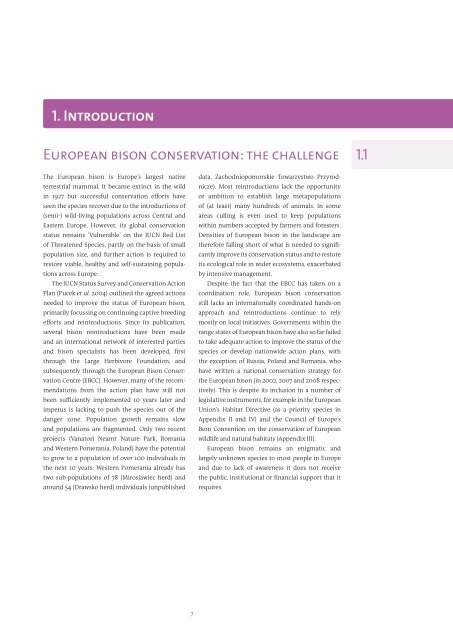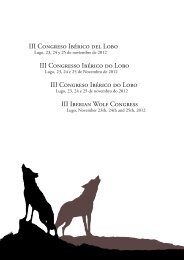Bison-Rewilding-Plan-2014
Bison-Rewilding-Plan-2014
Bison-Rewilding-Plan-2014
- No tags were found...
You also want an ePaper? Increase the reach of your titles
YUMPU automatically turns print PDFs into web optimized ePapers that Google loves.
1. IntroductionEuropean bison conservation: the challenge1.1The European bison is Europe’s largest nativeterrestrial mammal. It became extinct in the wildin 1927 but successful conservation efforts haveseen the species recover due to the introductions of(semi-) wild-living populations across Central andEastern Europe. However, its global conservationstatus remains ‘Vulnerable’ on the IUCN Red Listof Threatened Species, partly on the basis of smallpopulation size, and further action is required torestore viable, healthy and self-sustaining populationsacross Europe.The IUCN Status Survey and Conservation Action<strong>Plan</strong> (Pucek et al. 2004) outlined the agreed actionsneeded to improve the status of European bison,primarily focussing on continuing captive breedingefforts and reintroductions. Since its publication,several bison reintroductions have been madeand an international network of interested partiesand bison specialists has been developed, firstthrough the Large Herbivore Foundation, andsubsequently through the European <strong>Bison</strong> ConservationCentre (EBCC). However, many of the recommendationsfrom the action plan have still notbeen sufficiently implemented 10 years later andimpetus is lacking to push the species out of thedanger zone. Population growth remains slowand populations are fragmented. Only two recentprojects (Vanatori Neamt Nature Park, Romaniaand Western Pomerania, Poland) have the potentialto grow to a population of over 100 individuals inthe next 10 years; Western Pomerania already hastwo sub-populations of 78 (Miroslawiec herd) andaround 54 (Drawsko herd) individuals (unpublisheddata, Zachodniopomorskie Towarzystwo Przyrodnicze).Most reintroductions lack the opportunityor ambition to establish large metapopulationsof (at least) many hundreds of animals. In someareas culling is even used to keep populationswithin numbers accepted by farmers and foresters.Densities of European bison in the landscape aretherefore falling short of what is needed to significantlyimprove its conservation status and to restoreits ecological role in wider ecosystems, exacerbatedby intensive management.Despite the fact that the EBCC has taken on acoordination role, European bison conservationstill lacks an internationally coordinated hands-onapproach and reintroductions continue to relymostly on local initiatives. Governments within therange states of European bison have also so far failedto take adequate action to improve the status of thespecies or develop nationwide action plans, withthe exception of Russia, Poland and Romania, whohave written a national conservation strategy forthe European bison (in 2002, 2007 and 2008 respectively).This is despite its inclusion in a number oflegislative instruments, for example in the EuropeanUnion’s Habitat Directive (as a priority species inAppendix II and IV) and the Council of Europe’sBern Convention on the conservation of Europeanwildlife and natural habitats (Appendix III).European bison remains an enigmatic andlargely unknown species to most people in Europeand due to lack of awareness it does not receivethe public, institutional or financial support that itrequires.7



